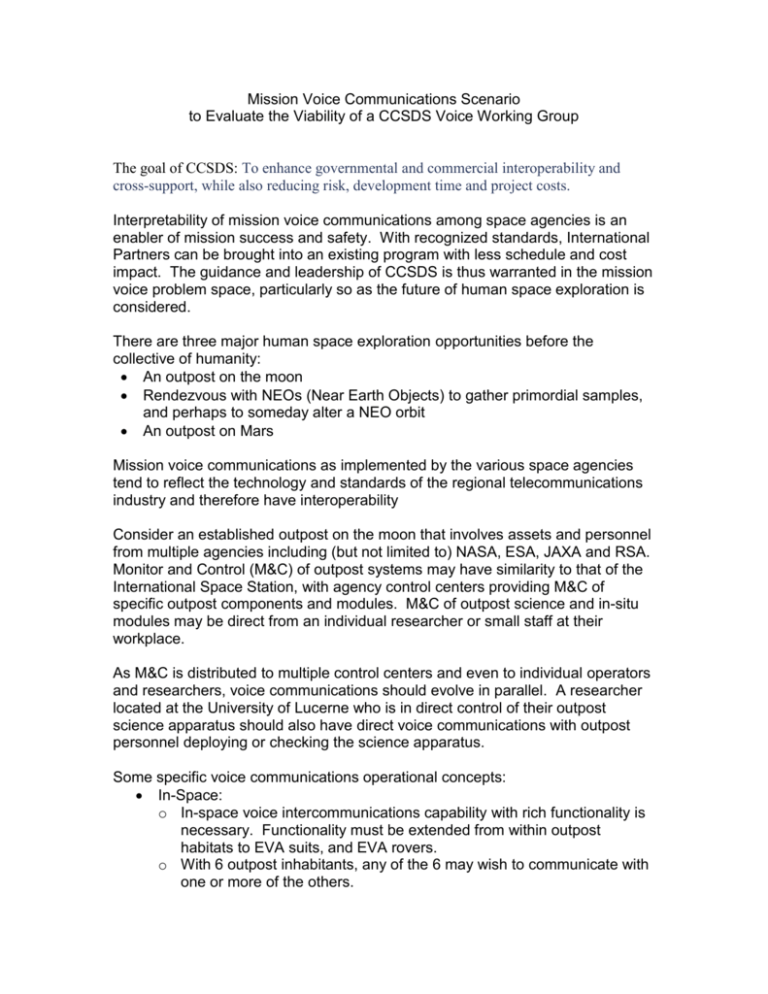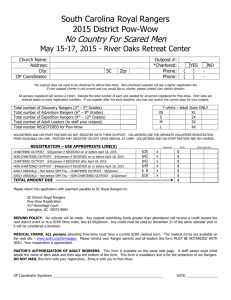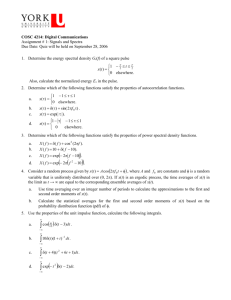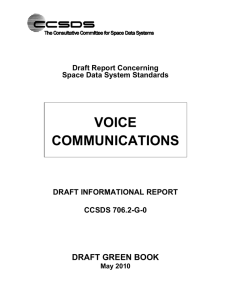Why Mission Voice Communications standards ought be put forth by
advertisement

Mission Voice Communications Scenario to Evaluate the Viability of a CCSDS Voice Working Group The goal of CCSDS: To enhance governmental and commercial interoperability and cross-support, while also reducing risk, development time and project costs. Interpretability of mission voice communications among space agencies is an enabler of mission success and safety. With recognized standards, International Partners can be brought into an existing program with less schedule and cost impact. The guidance and leadership of CCSDS is thus warranted in the mission voice problem space, particularly so as the future of human space exploration is considered. There are three major human space exploration opportunities before the collective of humanity: An outpost on the moon Rendezvous with NEOs (Near Earth Objects) to gather primordial samples, and perhaps to someday alter a NEO orbit An outpost on Mars Mission voice communications as implemented by the various space agencies tend to reflect the technology and standards of the regional telecommunications industry and therefore have interoperability Consider an established outpost on the moon that involves assets and personnel from multiple agencies including (but not limited to) NASA, ESA, JAXA and RSA. Monitor and Control (M&C) of outpost systems may have similarity to that of the International Space Station, with agency control centers providing M&C of specific outpost components and modules. M&C of outpost science and in-situ modules may be direct from an individual researcher or small staff at their workplace. As M&C is distributed to multiple control centers and even to individual operators and researchers, voice communications should evolve in parallel. A researcher located at the University of Lucerne who is in direct control of their outpost science apparatus should also have direct voice communications with outpost personnel deploying or checking the science apparatus. Some specific voice communications operational concepts: In-Space: o In-space voice intercommunications capability with rich functionality is necessary. Functionality must be extended from within outpost habitats to EVA suits, and EVA rovers. o With 6 outpost inhabitants, any of the 6 may wish to communicate with one or more of the others. o o o o Person to person. Local voice conference loops Voice communications may be ad-hoc, or formally scheduled. Ad-hoc voice communications might be accomplished like a cell phone call person to person call. o With n inhabitants, there might be n separate and unique voice conversations with earth side support personnel. o Additionally, for formal intercommunications, each inhabitant may chose to monitor more than one ongoing voice channel. o Voice communications include that within outpost habitats, with those outside engaged in EVA, among those out participating in the EVA, and with those in a rover/vehicle. o Mission voice communications interoperability includes between participating and non-participating agencies, their outposts, their EVA personnel, their rover and other networked assets. Earth Side: o Within a control center, numbers of mission support personnel engage in voice intercommunications. o The personnel of a control center intercommunicate with the personnel of other control centers. o Individuals located in place other than control centers may also engage in voice intercommunications with control center located personnel, as well as with outpost inhabitants. o Person to person. o Local and extended conference loops. SpaceLink: o Bandwidth constraint varies with mission phase. During launch/land, bandwidth is very limited. Digital encoding results in large numbers of small packets whose headers use a disproportionate amount of available bandwidth. o Bandwidth available occurs at three distinct rates, 24/18 kbs, 192/72 kbs and 1 mbs. Bandwidth challenges are extreme at the lowest level and significant at the typical launch/land level. o More than 2 voice channels may not be possible during low bandwidth mission phases. o Commercially available products are challenged by extending their use on the spacelink. o Command, telemetry, video, data and file transfer share bandwidth with voice communications over the spacelink. Current mission voice systems are centralized, a specific center has the ‘circuits’ for a space asset and processes all voice communication to/from that asset. This includes making and managing any cross connects to/from all other participating centers and agencies. Voice communication interoperability should provide a less centralized approach. CCSDS recommendation premise: to develop the following CCSDS standard books. Magenta Book to define the practices for mission voice communications, particularly for earth side voice intercommunications and in-space local voice intercommunications Blue Book to define standards for the spacelink, which is a major point of challenge for mission voice communications. International inhabitants voice communications among themselves, and directly with their earth side support staff Science support personnel can be located at their workplace exercising or in control centers In-situ In-situ Spacelink bandwidth will always be of concern. For if there is unused bandwidth someone will find a need and use it all... Satellites or orbiting crew modules facilitate voice communications traffic among the inhabitants, and to/from earth The ISS provides a prototype and testing environment for voice protocols and technologies of future exploration missions Mission Voice Communications Scenario Diagram Level zero processing, beyond which voice communications is distributed directly to participating agencies. Agency control centers are in direct control of moonbase science. And have direct voice communications with moonbase inhabitants








